Welcome to the roads of cycling legends! The northern region of Italy is dominated by several high mountain ranges which share borders with France, Switzerland, Austria and Slovenia. In the north-western corner is Valle d’Aosta and we actually covered a number of the famous road cycling climbs, such as, Sestrieres, Colle delle Finestre, Mont Cenis and Col de Montgenevre in our French Alps cycling web-guide. To the north-east is the Carnic Alps which border Slovenia and where the 2020 Giro d’Italia explored the Italian Fruili region. Click here for a cycling travel itinerary between Fruili and Slovenia.
However, when it comes to major Italian road cycling interest it is the Dolomites and Stelvio National Parks which always capture the most imagination and these two regions are featured in this blog. There are many incredible mountain passes to be conquered in the Italian Alps and the two regions are really only separated by a 2 hour drive when moving from Canazei (western section of the Dolomites) to Silandro (to the east of the Stelvio National Park).
In this blog we share our road cycling knowledge and offer suggestions on where to start your Italian Alps cycling holiday, the famous ‘passes’ on offer, some of our favourite cycling routes including profiles and options of where to base yourself to get the most out of your cycling adventure.
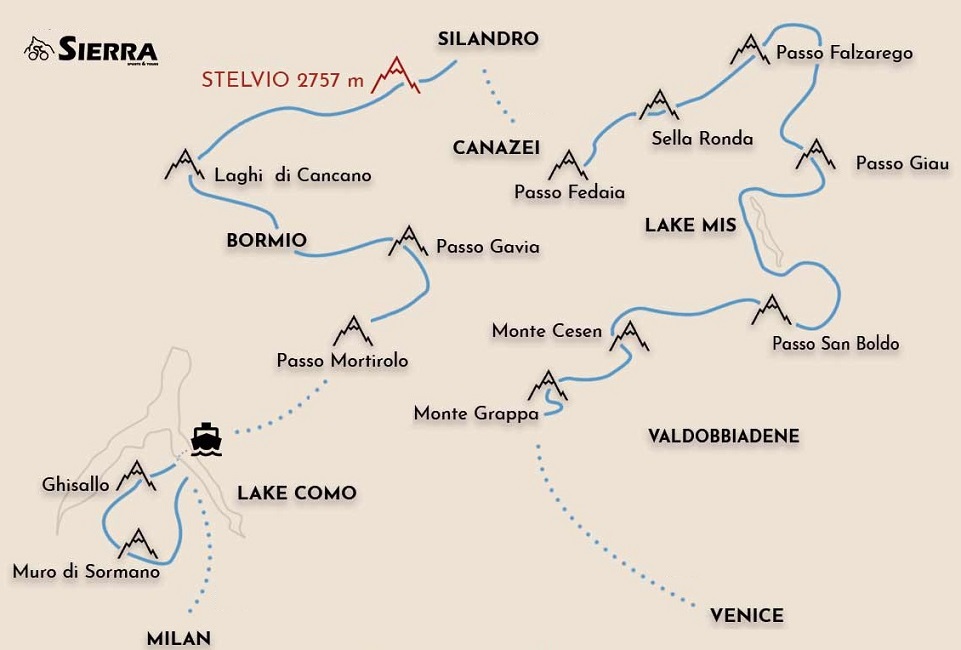
Contents
Where to Start your Italian Alps Cycling Holidays
Venice (Italy)
Venice is a favourite travel destination for so many and a great place to also kick-off an Italian cycling holiday. The roads leading out of Veneto cross into the pre-Alps and the views to the limestone peaks show that the Dolomites are so tantalizing close.
If you are going to spend some time looking around Veneto the Prosecco Wine Region is a good starting point and some classic Giro d’Italia climbs, such as, Monte Grappa and San Boldo Pass will get you well and truly warmed-up for the Dolomites. All of this is only a 45-60 minute drive away from Venice.
From Venice a 2hr drive will find you in Cortina d’Ampezzo a hot spot for outdoor winter and summer activities in the Dolomites. Passo Tre Croci, Tre Cime di Lavaredo, Passo Giau and Passo Falzarego are just a few of the immediately accessible climbs. In addition, to find yourself on the Sella Ronda cycling route one can drive approx. 2.5hr from Venice and be settled in Canazei, Arraba or Corvara and ready for some Dolomites cycling action.
To arrive in Venice you will be booking your flights into Marco Polo International Airport.
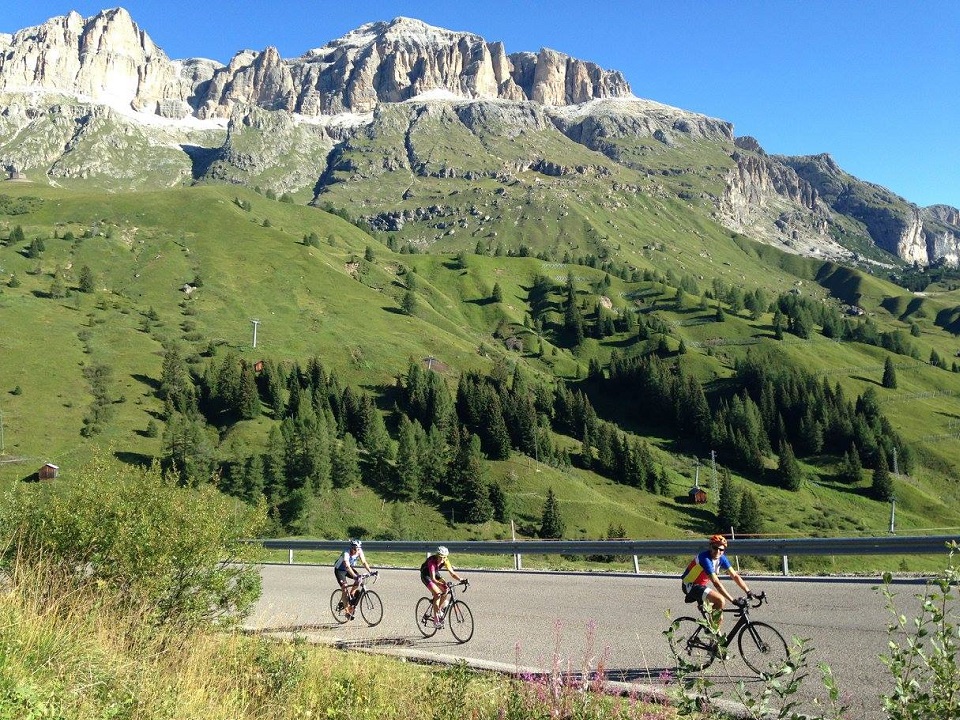
Milan (Italy)
Milan is another major centre for international travellers. By arriving in Milan the Stelvio National Park is closer so we suggest moving across northern Italy from west to east where you could later finish up with some Dolomites cycling routes. If you would like a cycling intro to break you into the swing of things from Milan we would recommend a visit to Lake Como first.
Como and Bellagio are only 45 minute and 1.5hr drives respectively from Milan Malpensa Airport and the region is home to the roads of the Giro di Lombardia (5th European cycling monument race). However, for those who want the big stuff straight away then you can arrive directly beneath the Italian giant climbs of Gavia and Stelvio with a 3.5hr drive from Milan to Bormio. Bormio much like ‘Cortina’ (Dolomites) is a major ski centre and is also a great base for summer cycling adventures.
Most international travellers arrive into Milan Malpensa which is the largest international airport in the metropolitan region. If you need to move between the Milan city centre and Malpensa airport the easiest way is to take an airport express train or bus which usually takes about 30-45 minutes.
Bolzano (Italy)
If your flight connections allow you to arrive to Bolzano airport then this is only a 1hr 15min drive east to Canazei on the western fringe of the Dolomites. Canazei is a lively town located immediately below the junction between Passo Sella and Passo Pordoi on the Sella Ronda cycling route. In addition, from Canazei the famous Passo di Fedaia climb from the Giro d’Italia is available which culminates up at the amazing Fedaia lake.
If you are lucky with a clear day then the lake provides an incredible vantage point to marvel at the Marmolada glacier which is the highest peak in the Dolomites.
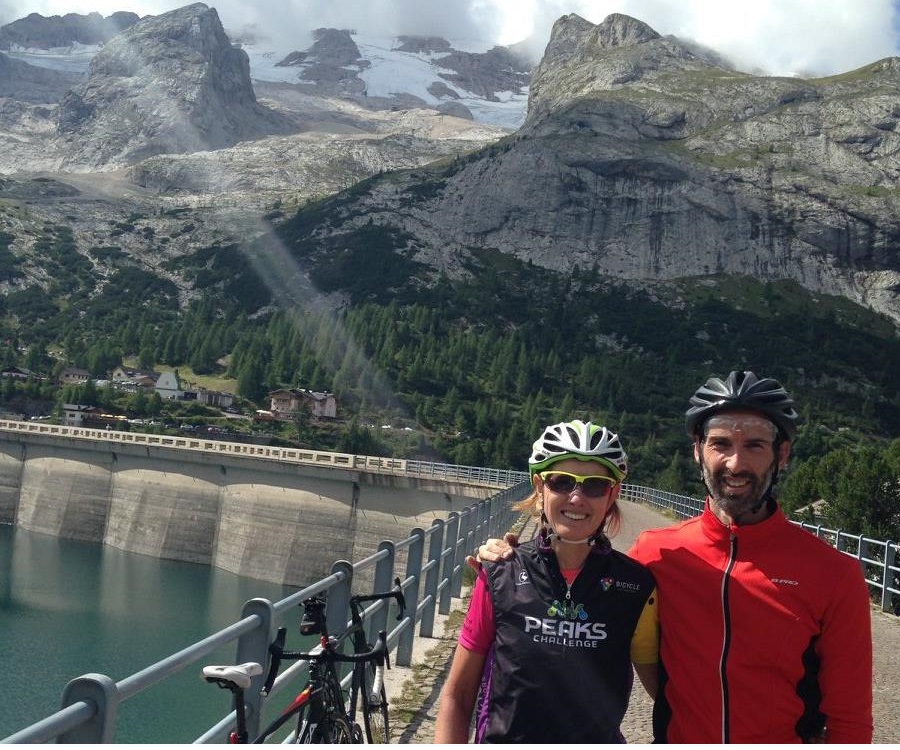
In addition, if you drive 1hr 15min to the west of Bolzano Airport you will find yourself in Prato Allo Stelvio township which sits below the Stelvio Pass. Here you will have access to the northern approach with its legendary 48 tornantes (switchbacks).
Zurich (Switzerland)
If some time in Switzerland also sounds appealing then Zurich is another option. Before arriving to Bormio which is a 4.5hr drive from Zurich why not make a stop off in St Moritz which is half-way on the journey. This high-profile alpine resort at 1822m elevation provides a blend of glamour, lifestyle, sport and pristine nature. You will also have the chance to sneak in some Swiss altitude training before taking on the Stelvio Pass!!
Bucket-list Road Cycling Passes
Now it is time to feature some of the truly great Italian Alps bucket-list cycling climbs. Over the last decade we have cycled the Dolomites National Park and Stelvio National Park regions year after year and can vouch for the amazing recreational and travel experiences on offer. In no particular order but cycling the Italian Alps means the following climbs, amongst many others, will be all yours – Passo Pordoi, Passo Giau, Passo Fedaia, Tre Cime di Lavaredo, Passo di Gavia, Umbrail Pass and Stelvio Pass!
Sella Ronda (Dolomites)
The Sella Ronda loop is one of the world´s most iconic cycling destinations thanks to its 4 climbs in one cycling route. It is a must for any cyclist who visits the towering Dolomites mountain region. There are 4 steps to become a member of the Sella Ronda club: Passo Pordoi, Passo Sella, Passo Gardena and Passo Campolongo. The views of the jagged limestone peaks, pine forests, alpine meadows and winding roads will be etched into your memory for a lifetime!
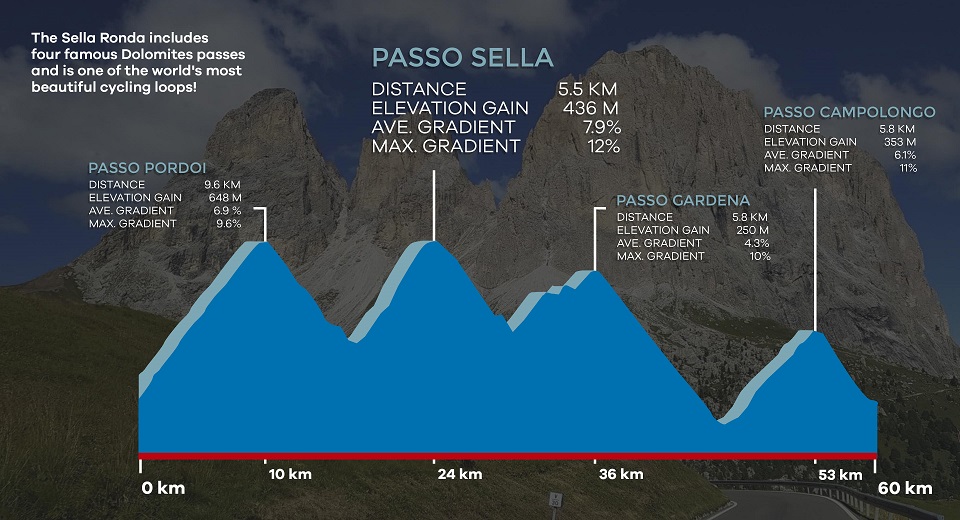
- Passo Pordoi: 9.2 km, Gradient: 6.9%
- Passo Sella: 5.5 km, Gradient: 7.9%
- Passo Gardena: 5.8 km, Gradient: 4.3%
- Passo Campolongo: 5.8 km, Gradient: 6.1%
The four above climbs are all jam-packed into a circular route that measures no more than 60km. Don´t let the relatively low kilometre count trick you though as each pass goes accumulating elevation, almost 1850m of elevation gain! The Sella Ronda is the core of the ‘Maratona dles Dolomites’ gran fondo cycling event. 9000 riders line up every year to tackle the Maratona which is described by National Geographic as “one of the biggest, most passionate, and most chaotic bike races on Earth”. Riding around the Sella Massif is about as good as it gets for mountain scenery!
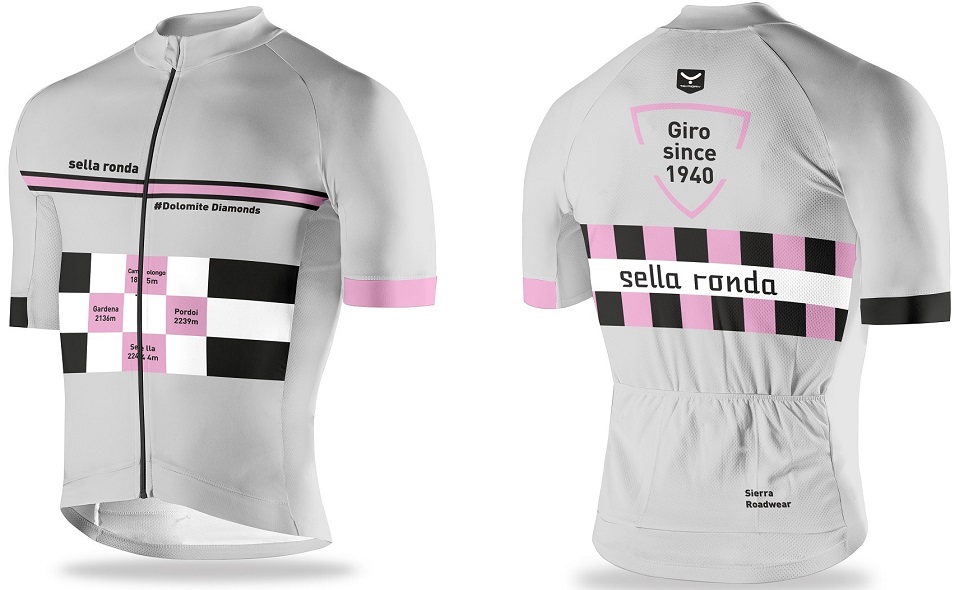
Passo Giau (Dolomites)
For most cyclists who have travelled Italy in and out ‘Passo Giau’ will be in their top 10 favourite cycling climbs. Giro d’Italia tragics will have especially heard about the southern approach of Passo Giau from Selva di Cadore. This Dolomites beauty measures 10.1km and the 9.1% average grade takes you up to 2236 metres elevation.
We typically access the Passo Giau (south) climb when we are already based in Arabba or when we arrive to the Dolomites from Caprile. Riding from either of these locations provide the perfect chance to complete ‘Giau’ and enter deep into the heart of the Dolomites national park. Just like Alpe d´Huez in the French Alpes, Km 1 of ‘Passo Giau south’ is its toughest with ramps constantly reading 10-12%.
At the summit you will be in awe of the seemingly sculptured mountain peaks surrounding you (Nuvolau, Lastoni del Formin, Cernera, Croda da Lago and Tofane). Passo Giau has been chosen various times as the Cima Coppi (the highest peak) in the Giro d’Italia cycling race. It is the highest mountain pass in the Cortina area and when combined with Colle Santa Lucia, Passo Falzarego or Passo Tre Croci it definitely makes for a Queen stage through the Dolomites. To find out some more about these other adjacent climbs please read later under ‘Cortina d’Ampezzo’ in our Where to Stay section.
Riding from the Cortina direction the Passo Giau ‘north’ ascent is also not without its own challenges. From Pocol the road tilts up and the 8.6km at 8.3% average grade winds its way through lush green fields and meadows filled with grazing cows. There are many sections with 6-8% grades making it a little friendlier than the slightly tougher’ southern approach.
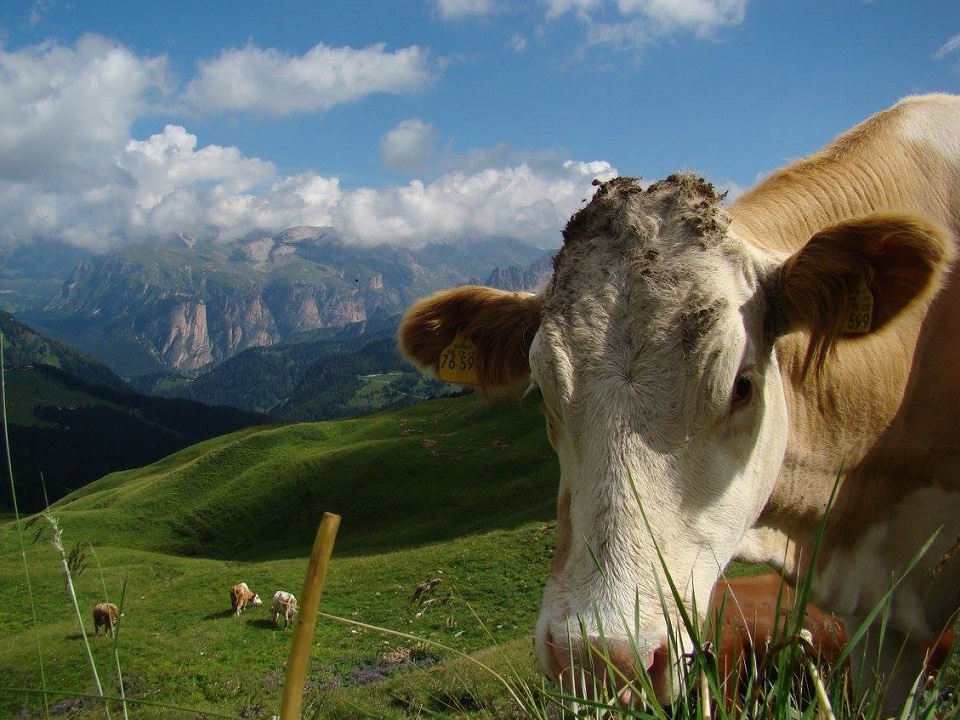
Passo Fedaia (Dolomites)
Passo Fedaia is another classic Giro d’Italia climb in the Dolomites and it was last used during the Queen Stage 14 of the 2018 Giro d’Italia. To make things really interesting we enjoy riding ‘Passo Fedaia’ from the east which takes you initially through the Sottoguda canyon (Serrai di Sottoguda). From Caprile there is 5km to the Sottoguda township which in itself averages 4% along the winding main road.
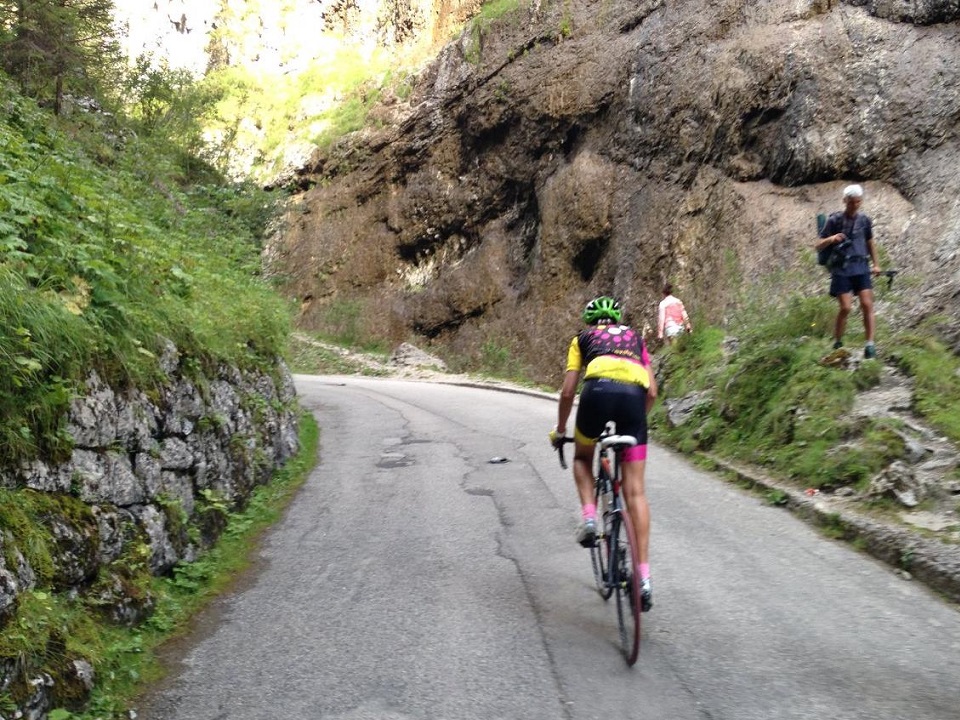
Turn off into the Sottoguda township and pay the 2 Euro fee to enter this wonderful gorge as it is well worth it. A narrow road with small waterfalls which freeze over in winter is something really unique. This is also a one-way cycling road (up, up and up only for cyclists) which links you back to the main Passo Fedaia road. The canyon detour is the best option as you avoid the tunnel on the main road.
The final 9km from Sottoguda average 9% up to the 2057m summit and several 12-17% ramps are real leg zappers. But the majestic Lago di Fedaia lake at the summit is the prize and it may even seem familiar to you seeing it was used as the backdrop to the ‘Italian Job’ movie.
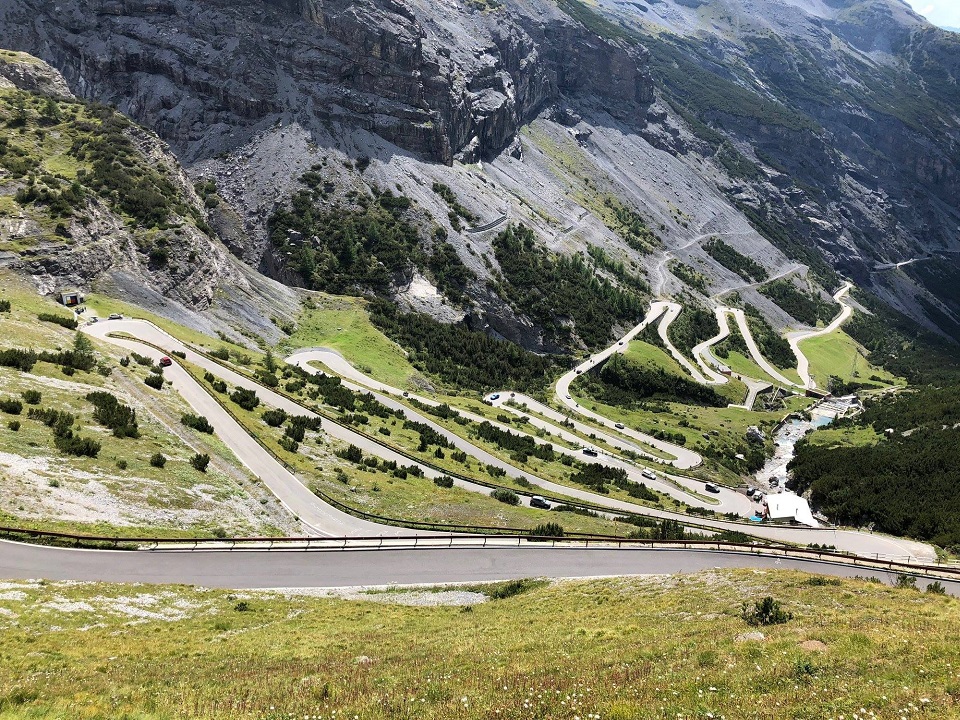
The western approach from Canazei is another quality climb. The ride measures 11.5km and the climb averages 6%. However, it is the final 4km where the grade hovers between 8-10% which will be the real test. At the top of the Fedaia pass there will be time to soak up the enormity of the Marmolada glacier which at 3343m elevation is the highest peak in the Dolomites. Talk about the perfect backdrop for a photo to remember!
Passo dello Stelvio (Stelvio National Park)
Passo Stelvio (2758m) is the highest asphalted mountain pass in the Eastern Alpes, second only to Col de l’Iseran (2770m) in the French Alpes in elevation and with more than twice the number of switchbacks as the famous Alpe d’ Huez. The climb is epic in every sense of the definition.
The north side of the Stelvio is the iconic, legendary climb from the Giro d’Italia. 7 of its 12 passings have been held during either Stage 20 or 21 highlighting its importance. With the Giro race held every May the norm is to watch the pro peloton climbing alongside walls of snow elevating it to a level of epic which is unparalled to the other two Grand Tour cycling races like the Tour de France or La Vuelta a España.
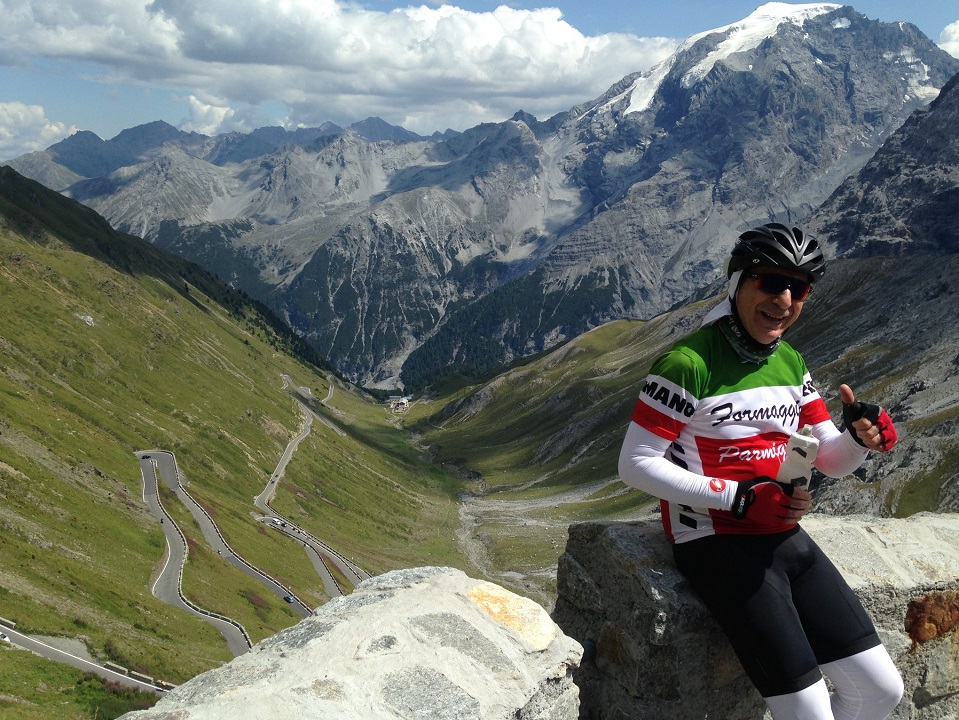
The mythical Stelvio north side with its 48 hairpin bends rise up and up for 25km and gain 1840 metres of elevation. The climb begins on exiting the Prato Allo Stelvio township but we usually like to begin from either Silandro or Glorenza.
Glorenza is a beautiful small town and by starting here there is a very friendly 10km warm-up ride to have you ready for what is just around the corner. From Silandro you can also ride along the bike path to the base of the Stelvio Pass. This path is predominantly asphalted however there are some gravel sections which in our experience are no problem for road bikes. Past guests of ours have found this 20km through the apple orchards and woodlands as a welcome ‘Stelvio’ warm-up.
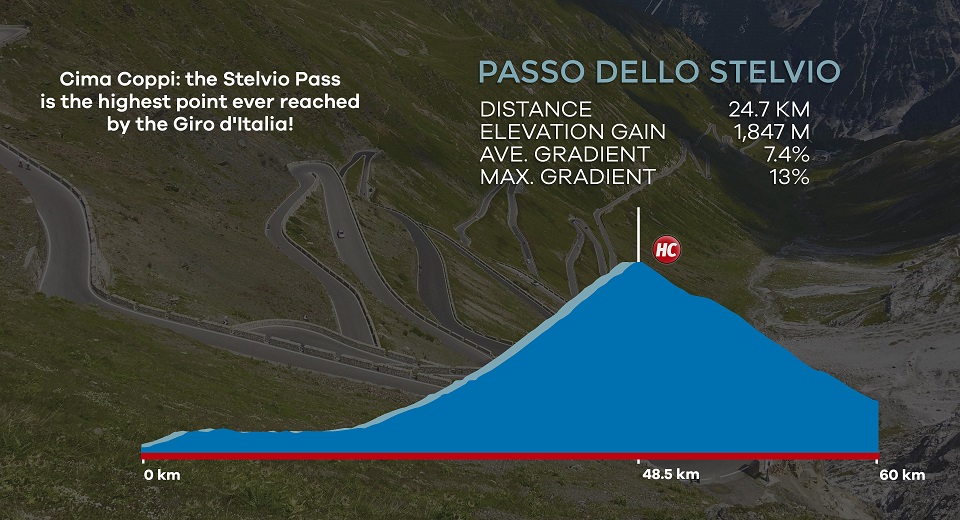
As mentioned above, when it comes to Giro d’Italia history, the Stelvio Pass has been contested on 12 occasions. It first appeared in 1953 when during the penultimate stage the Italian legend Fausto Coppi attacked on the Stelvio Pass to take the lead and secure victory in Bormio. This guy Coppi was pretty good right! This would be his fifth and final Giro title and all thanks to the Stelvio.
Did you know that in 1952 the Tour de France first rolled out Alpe d’Huez? Well the Giro d’Italia retailiated the following year by showcasing the Stelvio Pass which has now become a true test for all avid recreational road cyclists. At the top be sure to take a bow to his majesty the Stelvio Pass. Your sense of achievement will be at an all-time high!
Stelvio Pass can also be attacked from Bormio village and more information on this ascent can be found later under Bormio in our Where to Stay section.
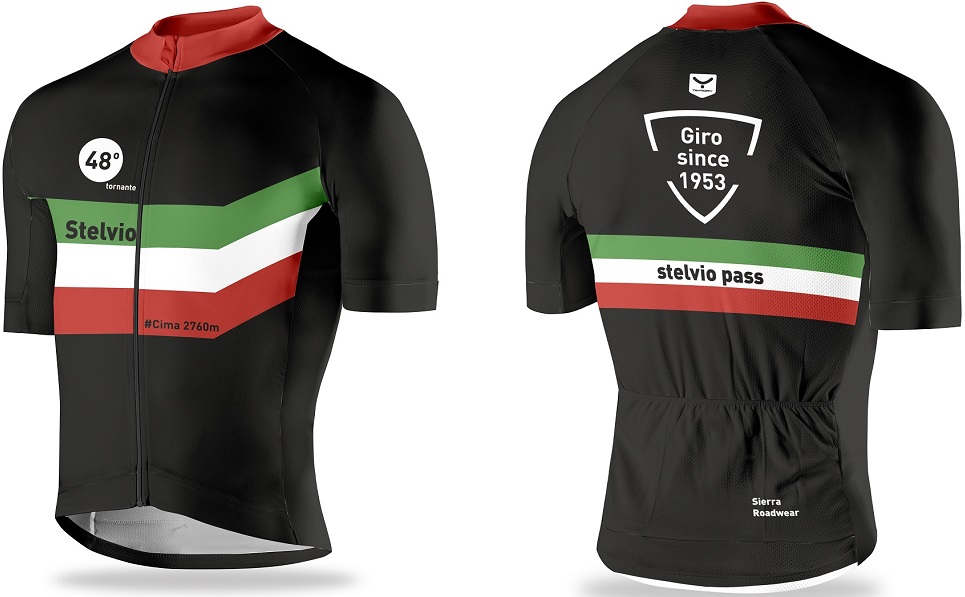
Passo di Gavia (Bormio)
Just like the Stelvio Pass, Passo di Gavia (2621m) also rises out of the Bormio sport village. This is just another mythical climb that has crowned many modern-day Giro d´Italia winners! ´Gavia´ with its 1400 metres elevation gain over 25km leaves one short of breath (5.5% average grade). From Bormio the climb begins as a major road accessing ski villages which then changes in a blink of an eye to a narrow remote mountain road which passes eerily through forest and later up into a barren glacier field.
The ‘real’ Gavia road begins at Km 12.5 with the first right hand switchback out of Santa Caterina ski village. We guarantee that you´ll never forget its tight switchbacks and steep ramps! Apart from all of its challenges we are always amazed to watch cyclists time trial the final two kilometres around the lake to the summit on a false flat!
- Km 0 – 6: Gradient: 2.5%
- Km 6 – 12.5: Gradient: 6.0%
- Km 12.5 – 23: Gradient: 7.4%
- Km 23 – 25.6: Gradient: 3.5%
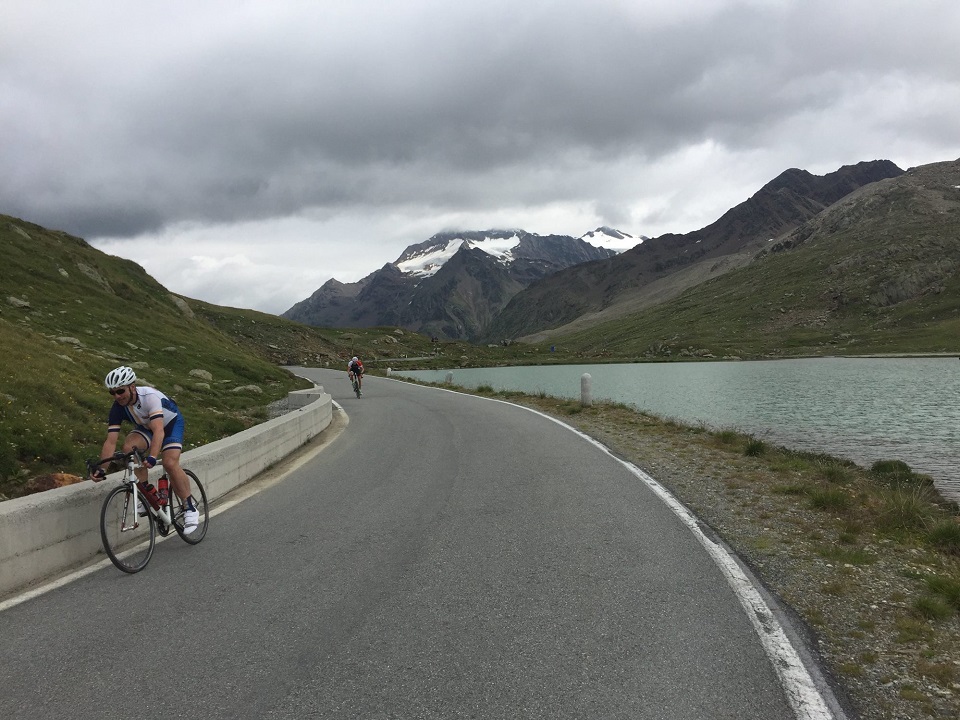
Moving away from Bormio and the Gavia cycling assault from Ponte di Legno is also a truly epic and rewarding climb. This is a 17km climb with a 7.9% average grade and includes 15 switchbacks which will forever be carved into your memory. The initial 3.5km are relatively straightforward but from there on expect 7-10% average kilometre grades with a couple of 13% and 14% ramps just for good measure. It is a good idea to have bike lights as near the top you pass through a tunnel. The final 3 switchbacks near the summit tightly twist up the mountain and the precipitous view down over Lago Nero is simply awesome!
Whichever way you climb to get there (Bormio or Ponte di Legno) the Gavia summit is a remarkable location and you will have to deal with its forever changing gradients. Near the summit you find the beautiful Lago Bianco with the Corno dei Tre Signori mountain (3359m) keeping guard. And right at the top the glacier means the temperature at this elevation are always quite low even in the middle of the summer. Jump into the family owned cafeteria (rifugio) for a nice hot chocolate or coffee!
Since 1960 there have been 10 Giro d’Italia crossings. Interestingly enough though the Gavia has also seen several race cancellations due to terrible weather conditions (1961, 1984 and 2013). Since the mid-1990s the Giro has scheduled 8 of its 10 Gavia crossings highlighting the desire of the modern race organisers to showcase this cycling giant as a true ‘Cima Coppi’ for the highest point in the race!
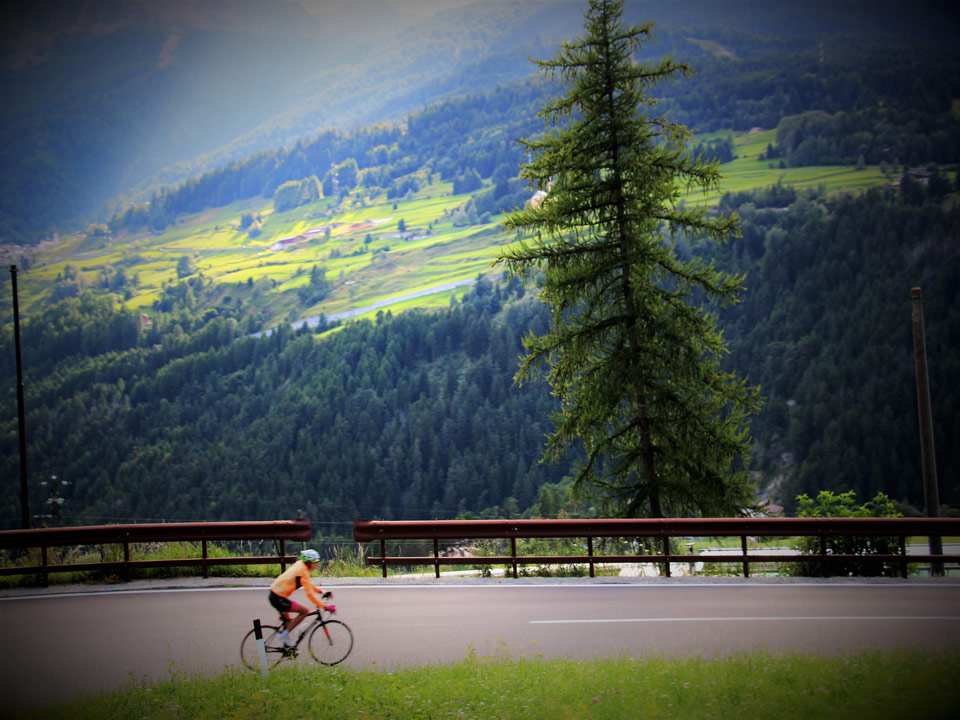
For some the Gavia climb is actually more difficult than Stelvio Pass due to its UNPREDICTABILITY. Stelvio is an engineered modern road, almost a mountain highway. The Gavia though is a lesser trafficked road which is often closed for longer periods of the year. The quality of the asphalt is poorer (in places really broken up), its rougher, the road widens and narrows, the switchback corners viciously ramp up rather than flattening and the weather is usually more extreme. Battling between how to ride the alternating flatter and steeper grades sees many riders push too hard before even entering the difficult upper sections of this famous mountain road.
Cycling Routes & Where to Stay
When considering cycling the Italian Alps you must first decide if you are looking to ride the Stelvio National Park, the Dolomites or both! If you are looking at combining the two regions then this will involve some strong legs and a sufficient amount of time to make sure your cycling holiday is not too rushed. If your aim is to ride both regions we would also recommend a vehicle to safely move you between these two cycling meccas and to also maximise the number of epic days of cycling available.
When looking at the Dolomites also remember that the Prosecco wine region is an excellent option for getting started on the bike. At the same time, Lake Como or the roads around St Moritz (Switzerland) will also provide a fantastic introduction leading you to the challenges that await in the Stelvio National Park.
Valdobbiadene (quick stop before the Dolomites)
If you have decided to arrive to Venice and want to put in some cycling before hitting up the Dolomites then keep Valdobbiadene on your radar. While it is not the Dolomites there are a number of brilliant loop rides through the rolling hills of the Prosecco and Cartize wine area. Following the landscapes of Italy’s prized sparkling wine is always a major highlight.
For those looking for a challenge then Monte Cesen which soars above Valdobbiadene, capital of Prosecco wine region, will break up any vineyard spin. The 18km climb at 7% average takes you up through the forest before passing the treeline and presenting its expansive views over the Veneto valley. This is a great test to judge if your legs are going to be ready for the nearby Dolomites. Travel is also all about combining great food and wine and a couple of nights in Valdobbiadene means you will be able to trial some of its fantastic agriturismo restaurants.
Any riding in the pre-Dolomites should also be sure to include Passo San Boldo. The road near the summit includes a series of five switchback tunnels carved into the rock! The 6km climb at 7.5% average was last contested during Stage 19 of the 2019 Giro d’Italia which an emotional Esteban Chaves went on to win! Rolling across the top of the plateau offers incredible views to the Dolomites. Is that snow we often get asked? No, there you have the limestone peaks of the soaring Dolomites which will now be your next stop!
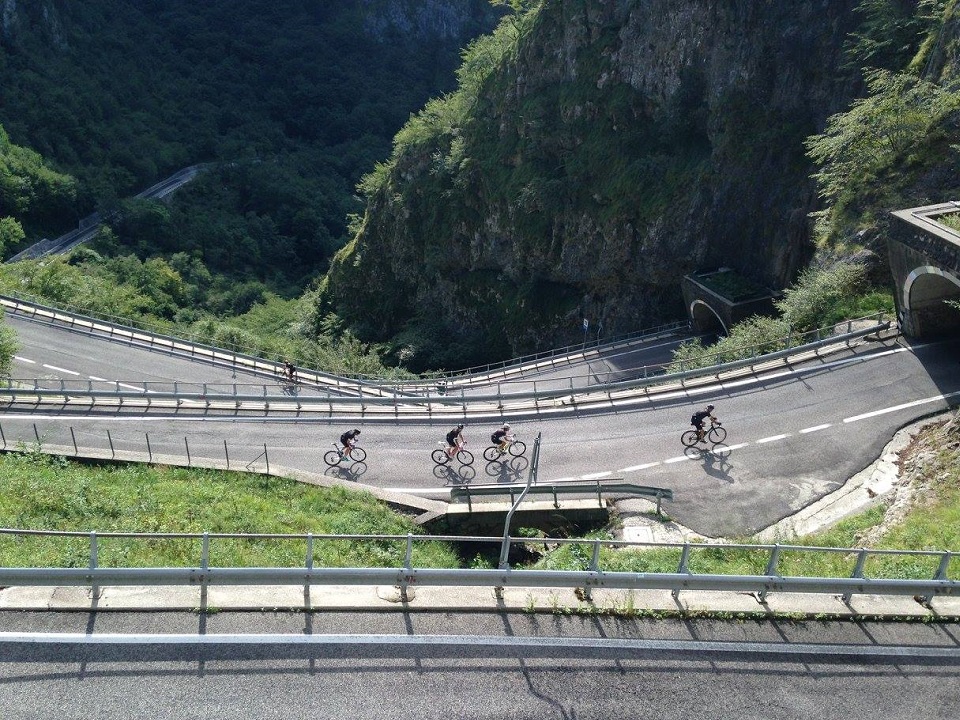
Cortina d’Ampezzo (Dolomites)
Cortina is well renowned as one of the premiere ski villages in the Dolomites. It has even been selected to host the 2021 ski world championships and the 2026 winter olympic games. But as the snow begins to melt and the mountain passes open up the road cyclists return to Cortina in their droves.
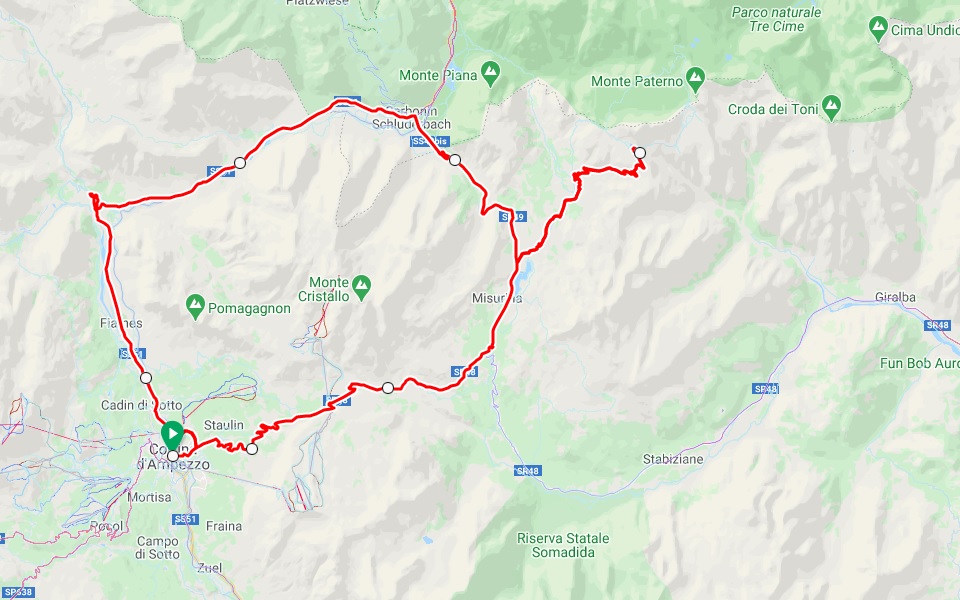
From Cortina one of our favourite rides begins with the Passo Tre Croci climb (8km and 7.3% average grade). The majestic Lake Misurina rests near the top of the climb at a staggering 1760m elevation and is the perfect place for a coffee or lunch stop. For those who would like an added challenge why not try your hand at the final 7km ascent to Tre Cime Lavaredo (average 8% grade). The numbers do not tell the true story though as the final 4km average 12%.
On arriving to the Auronzo Refuge at 2300m the sheer size and beauty of the ‘Tre Cime’ Dolomites rock formation will take over! If you want to take longer to enjoy Lago di Misurina then please avoid the brutal climb up to Tre Cime di Lavaredo and just continue the cycling loop back to Cortina. The short loop includes 40km and 1000m of climbing while the total loop ride up to Tre Cime measures 55km and 1575m elevation gain.
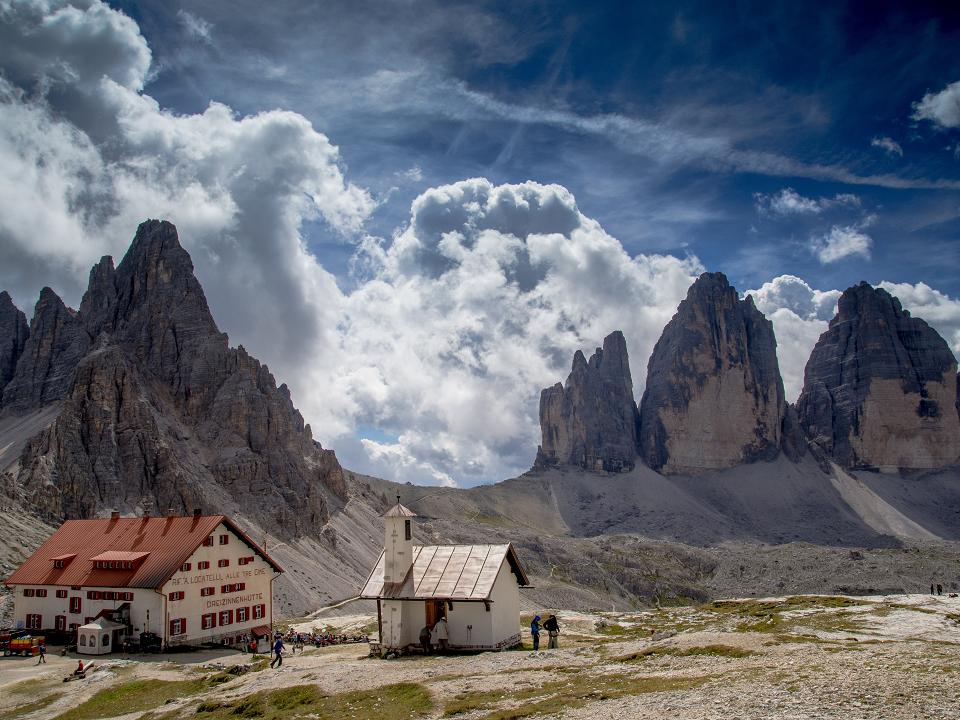
As we mentioned earlier, from Cortina it is also only a short ride to Pocol and access to ‘Passo Giau north’ if you are looking for a simple straight out and back ride option. For those wanting another loop ride then we recommend following an epic Cortina ride which combines Passo Falzarego (10km at 5% average grade) and Passo Giau south. Again the distance at 65km does not sound overly taxing but the 2125m elevation gain is a solid workout!
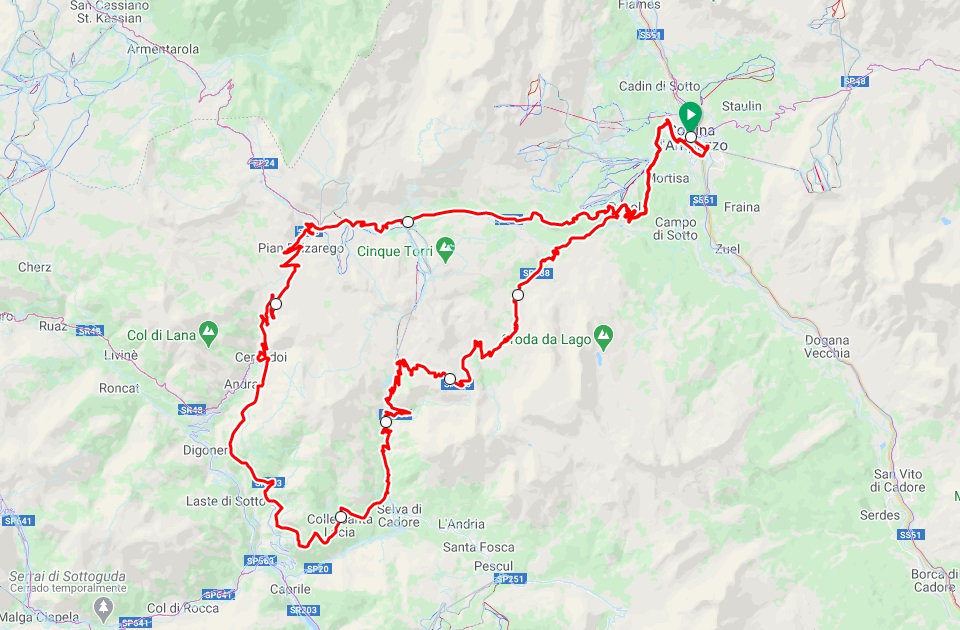
It is also possible to move Dolomites cycling bases by riding from Cortina to other nearby towns, such as, Arabba or Corvara. The rides to Arraba and Corvara both measure approximately 35km and and include 1100m elevation. Both routes need to first cross Passo Falzarego. Arabba: from the summit follow the directions towards Caprile and after 10km of descent follow the signs to Arabba. Corvara: from the summit continue on another 1.5km and pick-up Passo Valparola as well before the long decent. 5km from Corvara turn off and cruise your way into town.
There may be some riders out there who have also heard of the mighty Monte Zoncolan climb. From Cortina it is a 2hr drive to Ovaro (at the base of Zoncolan) and while a long day trip it is still possible with an early start to ride what we think is within the top 3 toughest asphalted climbs in Europe. With climb statistics that put it in the same league as Mortirolo (Italy) or Angliru (Spain) it is one ‘out and out’ challenge.
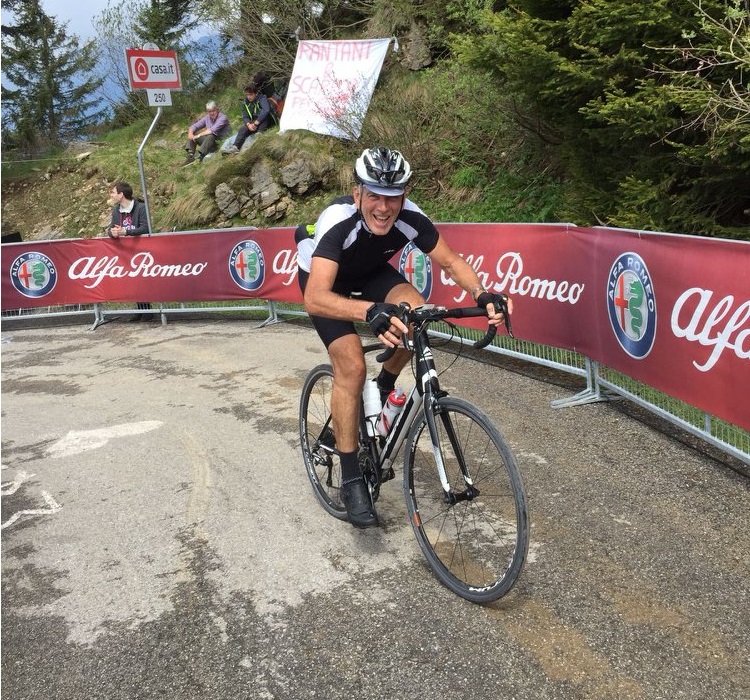
The western approach from Ovaro is considered the most difficult – 10.5km with an average grade of 11.5%. The final 6km though average 15% with a maximum ramp of 20%. The eastern approach is not that much easier, however, its 13.5km with an average grade of 9% look a lot more achievable on paper. The final 3km though average 13% and an 80m ramp of 27% still lurks only 1.5km from the top. This Zoncolan climb should only be attempted by those cyclists who are keen to test themselves on an authentic Italian wall.
Arabba, Corvara or Canazei (Dolomites)
Any of these three towns nestled in the heart of the Dolomites are well placed for your chance to ride the four categorised climbs which make up the Sella Ronda. Arabba is the smallest of the towns and has more of a village feel about it. There are only a couple of restaurant options, a small supermarket and no bike shops at the time of writing. At 1600m elevation and with high mountain escarpments all around it really feels like you are staying in the heart of the mountains.
Canazei and Corvara are quite similar in size (bigger than Arabba) and have a lot more dining, bars and shopping options including bike hire and ski/bike related shops. Canazei at 1450m and Corvara at 1570m are both at altitude but with extensive green fields immediately surrounding the townships the feeling of a high mountain ski resort is not as strong as Arabba in our opinion. Corvara is also home to the Maratona dles Dolomitas gran fondo mass participation cycling ride and for that reason has gained significant recognition in the cycling community.
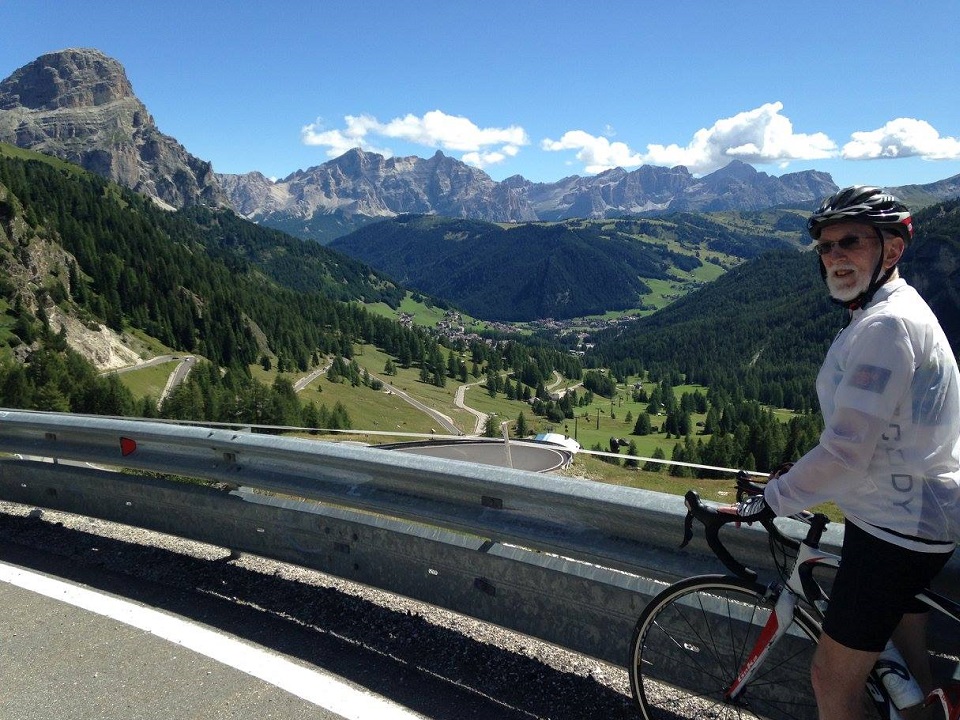
If you only have a night or two available but would like to cycle a piece of the Dolomites we would recommend staying in Canazei. Using this as your ‘quick-stay’ base means that you could quite easily complete the Sella Ronda cycling loop route and also Passo Fedaia which is no mean feat!
Bormio (Lombardy)
We have already covered off the Stelvio and Gavia climbs as two major cycling feats from the Bormio village. However, there is also a lot more to like about this all-year round sports village. Any extended stay in Bormio can also include ride options up to Bormio 2000, Laghi di Cancano, Umbrail Pass, Passo del Foscagno and Mortirolo.
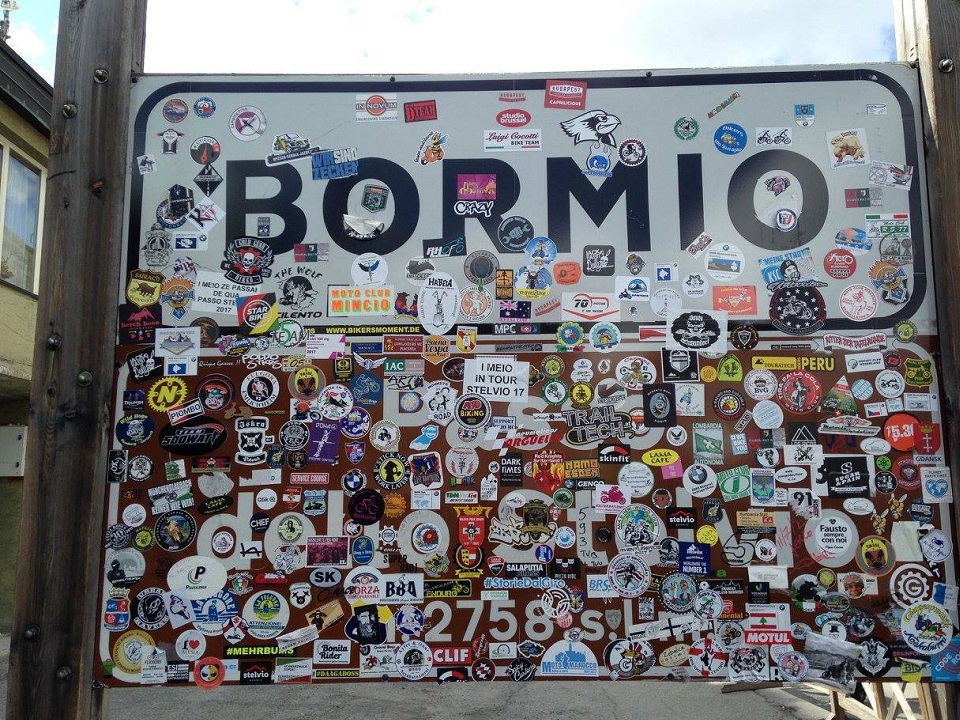
Bormio 2000
‘Bormio 2000’ is an excellent ride option also rising up out of the Bormio village. This road hairpins all the way from the valley town up to the ski station (10km at 7.5% gradient). Admire the views of the valley below before descending back down to the village centre. We often use this climb as an optional extra after a day on the Stelvio or Gavia if our clients still have a little more energy left in the tank.
Laghi di Cancano
Laghi di Cancano is another 10km climb starting very close to the town centre which takes you up to the 2020 Giro Stage 18 summit finish. The first half of the climb scales the side of the valley before the final section converts into a series of curving switchbacks. At the 8km mark you pass the two medieval towers (Torri di Friale) before pushing onto the rifugio and the spectacular views over the lake. If you have a gravel bike you can explore even further whilst enjoying this corner of Bormio.
Umbrail Pass
The Umbrail Pass on the Italian/Switzerland border is another epic cycling ride option from Bormio. In reality you are cycling the southern side of the Stelvio Pass but veering off towards Switzerland at about 3km from the Stelvio summit. If you have the legs ride the 21.5km climb to the Stelvio summit (7.2% average grade), descend 3km back to the Switzerland turn off and ride the few hundred extra metres to Umbrail Pass. Now you have intersected the Umbrail Pass summit at 2501m elevation which is officially Switzerland´s highest mountain pass. This climb passes through some narrow rock tunnels (Stelvio Pass ‘south’) so be sure to bring your bike lights and some high visibility clothing.
Continuing with the Umbrail Pass theme and complete your monster loop which combines the best of Italy and Switzerland. It includes a spectacular descent of the Umbrail Pass all the way down to the Swiss Val Mustair valley. More information on this ride option is available in our blog ‘10 Best European Cycling Routes’ but at 105km and 3600m elevation gain you can imagine the day that is awaiting you! To complete the loop one must contend with a final climb of the northern Passo Stelvio ascent which was described earlier in the Bucket-List Cycling Pass section before the fun descent back down to Bormio.
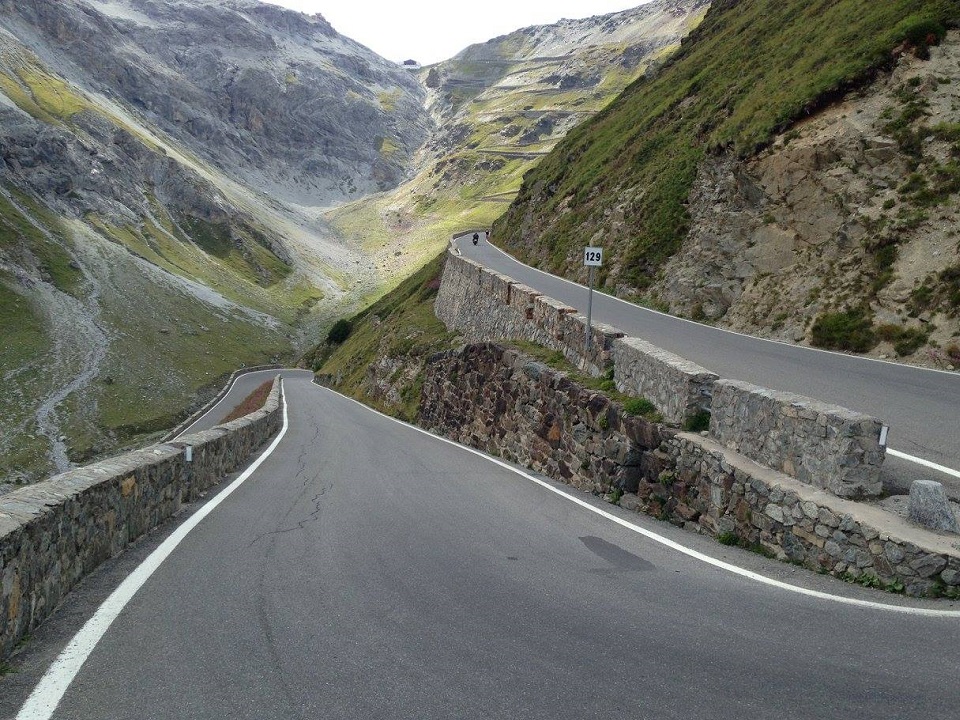
Passo Foscagno
From Bormio a logistically easy ride is an out and back ride to Passo Foscagno in the direction towards Livigno. Get out early and tackle this 24km climb up to 2291m altitude before the masses of tourist vehicles hit the road (particularly take care in summer). The first 9km are a relative breeze, however, the final 15km offer a fairly constant 6% average grade. You can continue another 13.5km onto Livigno which includes another few kilometres of climbing over Passo Eira but we believe there is better cycling scenery in the region. If you decide to ride to Livigno though get started on the Stelvio Pass and at Tornante 38 follow the signs to Livigno. In total you will have ridden 75km and climbed approximately 2100m elevation by the time you get back to Bormio.
Mortirolo (Passo della Foppa)
When it comes to epic Bormio cycling routes the Mortirolo/Gavia loop ride is what gets us really fired up. What a way to finish up this blog! Mortirolo (aka Passo della Foppa) is definitely in our toughest five cycling challenges in Europe. The road was always a secondary mountain route and only became asphalted in 1990. With this a new page in the Giro history books was opened.
Over the last 30 years there have been as many as 14 Giro d’Italia crossings and names such as Marco Pantani, Ivan Basso, Steven Kruiswijk and Luis Leon Sanchez have all lead the peloton over this 1851m elevation summit. It will be a great chance for those of you eager to experience an authentic Italian wall. Our ‘Giro d’Italia – A Trip Down Memory Lane‘ blog writes about a young Pantani and his impressive escape on the Mortirolo during Stage 15 of the 1994 Giro d’Italia.
This special Bormio loop ride measures approximately 115km and includes 3400m of elevation gain. From the town centre head south on the SP27 road. Make sure to stay clear of the SP38 as this includes a number of dangerous tunnels. On arrival at Mazzo di Valtellina follow the Mortirolo signs and get set for the fearsome 12.5km climb with a 10.5% average grade. When you hear of the professionals riding at 8km/hr it is pretty clear that you will struggle at times during this climb and the ability to alternate between sitting and standing will be extremely helpful. Just like Alberto Contador in the 2015 Giro d’Italia you might consider a change of bike at the base of the climb which also has a triple chain ring!!
The descent towards Monno is a beautiful experience winding down some awesome switchbacks before following the main road to Ponte di Legno. We have already mentioned what to expect on Passo Gavia in our earlier section ‘Bucket-List Road Cycling Passes’. Enjoy your ride back to Bormio but always take care as a high level of concentration will be required for some of the tight switchbacks.
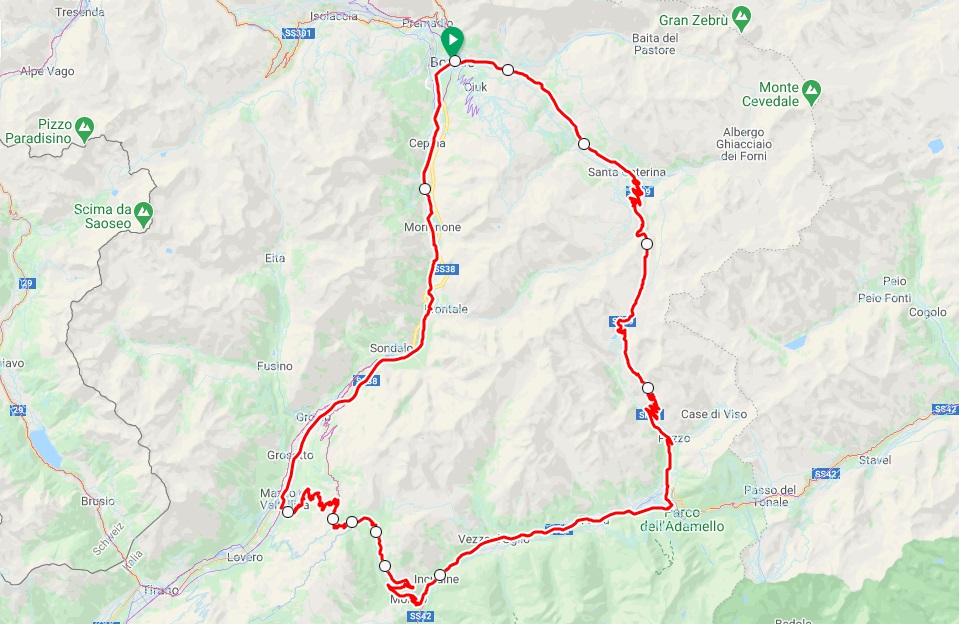
Final Cycling Challenge Words
The weather when cycling in the Italian Alps always needs to be carefully assessed. Early June to late-September is typically a good period to visit for road cycling. However, there is nothing set in stone as it is still very much a season to season proposition. We have climbed Stelvio Pass for example in early August in bright sunshine to then find out a week later it was snowing on the summit in the middle of summer!
The summit elevation should therefore always be considered. The cycling season is usually a few weeks longer in total for major passes with elevations between 1500-2000m compared to those between 2250-2750m. Be sure to give this some serious consideration if a giant mountain pass like Passo di Gavia or Passo dello Stelvio is on your hit-list. As already mentioned, the weather during the peak of summer can also change from one extreme to another daily so always come prepared with the appropriate cycling gear especially if you will be riding without a support vehicle.
Do you think you are now ready for some cycling in the Italian Alps? We hope you have found our guide to cycling the Stelvio and Dolomites National Parks useful. If you have any questions regarding the famous passes on offer please feel free to Contact Us and we will be pleased to assist. If you would like to conquer these famous climbs click here to visit our next ‘Epic Italian Alps’ cycling tour itinerary.
Other sources of road cycling information that you might find useful and which have been prepared by the crew here at Sierra Sports & Tours include:
